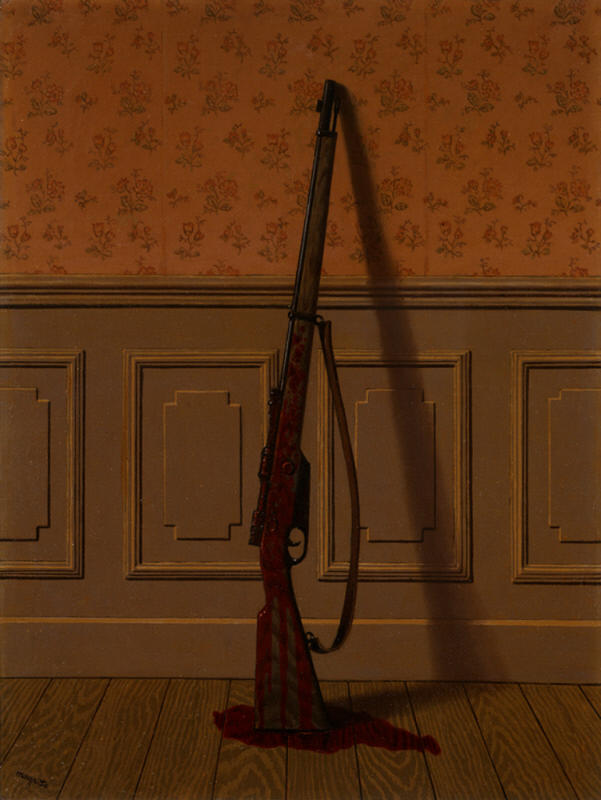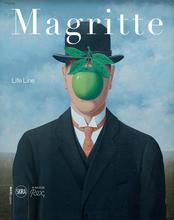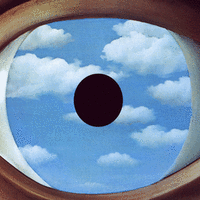More about The Survivor
- All
- Info
- Shop

Contributor
Magritte’s images never cease to puzzle us and perhaps that is why his works have gained so much popularity.
The Belgian artist sought to question our understanding of objects, images, and their meaning by placing them in strange, comical, and curious contexts. Objects, in his paintings, often defy gravity, other principles of physics and logic for that matter. This particular painting, Le Survivant, or The Survivor, was painted for the 1950 exhibition L’Art et la paix held in Lyons, France. In this painting, a tranquil background with floral wallpaper and quaint wooden floorboards are met with the violent image of a bleeding gun. Not surprisingly, the painting sparked a heated discussion during a selection process in Belgium. This painting would likely start a controversial debate today as the country comes to grips with its loose gun laws and frightening number of shootings in recent years. While the NRA might title it, “Ceci n’est pas le problème”, Magritte chose to title the painting, “The Survivor”.
The artist’s titles are just as unsettling as the paintings themselves. This title sends the viewer off on an internal search for the survivor of the painting. Who is the survivor? Where is the survivor? Is he aware of the irreversible damage the pool of blood can do to the hardwood floors? Will bleach help? Is the survivor out to get bleach? Is there a survivor at all? We can’t, of course, rule out that the artist has personified the object in question and is calling the gun the survivor. Paul Noug, a friend of Magritte’s thought “I am quite well placed to know that it is almost never Magritte who invents the titles of his pictures. His paintings could do without titles, and that is why it has sometimes been said that on the whole the title is no more than a conversational gambit”. Perhaps the gun symbolizes something but Magritte himself warned against attaching symbolism to his paintings, to him “images are images, just that.”
Magritte’s paintings were meant to question the viewer’s understanding of reality and his style soon became quickly recognizable. Even those who dealt in the black market deemed Magritte’s paintings too recognizable to acquire. In fact, in 2009, Magritte’s painting of Olympia was stolen from the artists’ former home and now, Magritte Museum. The painting was later returned to the Magritte Museum two years later after it couldn’t be sold in the black market. The owner’s insurer had to pay £62,000 in ransom to get the painting back, which luckily was still in “pristine condition”.
Sources
- “Gallery 1949-1960 Mature Period,” Matteson Art, accessed: Feb 26, 2018. http://www.mattesonart.com/1949-1960-mature-period.aspx
- Itzkoff, Dave, “Magritte Painting Stolen,” ArtsBeat, NYTimes Blog, September 24, 2009, accessed: Feb 26, 2018. https://artsbeat.blogs.nytimes.com/2009/09/24/magritte-painting-stolen/
- Southgate, M. Therese, “Rene Magritte: Le Survivant,” The Art of JAMA: Covers and Essays from The Journal of the American Medical Association. Vol. 3, (USA: Oxford University Press, 2011). https://books.google.com/books?id=75yZ9vMLeBYC&dq=magritte+the+sur
- “Stolen Rene Magritte Masterpiece Returned,” Artlyst, January 7, 2012, accessed: Feb 26, 2018. http://www.artlyst.com/news/stolen-rene-magritte-masterpiece-returned/
- Whitfield, Sarah, “101. The Survivor,” Magritte, (London: The South Bank Centre, 1992).














This artwork is awe-inspiring and full of technical painting nuances.